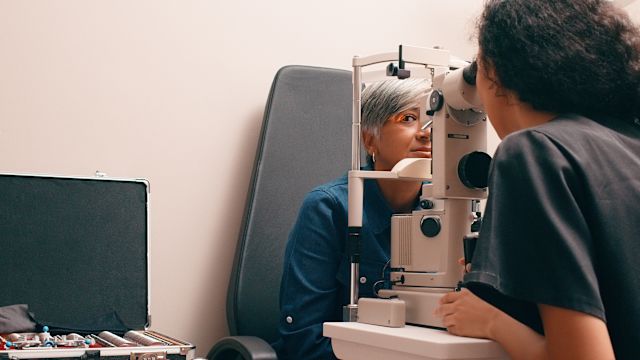Updated on December 14, 2023
When you are living with a health condition, it helps to learn as much as you can about that condition. When you are learning about a health condition, it helps to understand the different terms associated with that condition.
With that in mind, here is a guide to several common terms related to diabetic macular edema (DME).
Eye and vision basics
To understand diabetic macular edema, it helps to have a basic understanding of the parts of the eye that are affected and the type of vision loss that occurs with DME.
- Vitreous. The clear, gel-like substance that fills the eyeball.
- Optic nerve. A cord made up of nerve fibers that connects the back of the eyeball to the brain.
- Retina. A layer of light-sensitive cells in the back of the eyeball. The light-sensitive cells that make up the retina are called photoreceptor cells. These cells convert light into signals that travel down the optic nerve to the brain.
- Macula. A dense cluster of photoreceptor cells at the center of the retina. The macula is what enables central vision—the ability to focus vision and clearly see objects that are directly in front of the eyes, including details, shapes, and colors.
- Fovea. (Also called fovea centralis.) The center of the macula. Densely packed with photoreceptor cells, it enables a person’s most detailed vision.
- Vision Loss. A vision impairment that cannot be fully corrected (for example, it cannot be corrected with glasses or surgery). People who have DME can experience vision loss.
- Central vision loss. Vision loss that interferes with central vision. This is the type of vision loss caused by DME.
Types of diabetic eye disease
Diabetic eye disease refers to several eye conditions that occur as a result of diabetes.
- Diabetic retinopathy. Diabetic retinopathy occurs when blood vessels that supply the retina become damaged and leak fluid into the vitreous.
- Proliferative diabetic retinopathy. An advanced type of diabetic retinopathy where new blood vessels form inside the eye. These new blood vessels do not function well, are easily damaged, and leak fluid.
- Diabetic macular edema (DME). A complication of diabetic retinopathy and diabetes. DME occurs when blood vessels that supply the retina leak fluid into the macula, causing the macula to swell. DME can occur at any stage of diabetic retinopathy, but it’s more common in the advanced stages.
- Glaucoma. A group of eye diseases that cause damage to the optic nerve. This damage often occurs as a result of pressure building up inside the eyeball. Having diabetes increases the risk of having certain types of glaucoma.
- Cataract. A condition where the eye’s lens (the front surface of the eye) becomes cloudy. People who have diabetes are more likely to have cataracts and develop cataracts at younger ages.
Treatment for DME
There is no cure for DME, and a treatment plan will likely include several strategies to slow disease progression, protect vision, and maintain quality of life.
- Diabetes ABCs (A1C, blood pressure, cholesterol). Elevated blood glucose, elevated blood pressure, and high levels of blood cholesterol all contribute to blood vessel damage in the eyes as well as other areas of the body. Controlling these numbers is an important focus of managing both diabetes and diabetes complications—including diabetic retinopathy and diabetic macular edema.
- VEGF. Vascular endothelial growth factor, or VEGF, is a protein that the body needs to grow and maintain blood vessels. Elevated blood glucose levels trigger the production and release of excess amounts of VEGF, and excess amounts of VEGF cause damage to blood vessels. This is one of the main contributors to the leaking blood vessels that occur in diabetic retinopathy and DME.
- Anti-VEGF therapy. The most commonly used therapy for DME, and also used to treat diabetic retinopathy and other eye conditions, including wet age-related macular degeneration. Anti-VEGF medications are delivered with an injection into the eyeball. This cannot cure DME, but it can slow the progression and improve vision in some cases.
- Corticosteroid. A category of anti-inflammatory medication used in nearly all areas of medicine. Corticosteroids are synthetic versions of hormones that are produced in the body. Some corticosteroid medications are used in the treatment of DME.
- Intravitreal injection. The technical term for an injection with a needle into the eye. Both anti-VEGF therapy and some corticosteroid therapies used to treat DME are given as intravitreal injections. A numbing agent is applied to the eye beforehand. Most people describe feeling pressure during an intravitreal injection, but not pain.
- Photocoagulation. A procedure that uses a laser to close leaking blood vessels in the eye. Before anti-VEGF medications became available, photocoagulation was a mainstay of treatment for DME. It is still used in some cases.
- Vision rehabilitation. Also called low vision rehabilitation or low vision therapy. During vision rehabilitation, a person who has experienced vision loss will work with a specialist to learn strategies for maximizing the use of existing vision. This may include using low vision aids, assistive technologies, and modifications to the home. Treatment goals include maintaining independence, safety, and quality of life.






